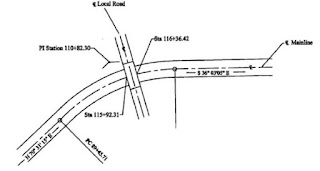Highway Alignment:
The position or the layout of the center line of the highway on the ground is called the alignment. The horizontal alignment includes the strait path,the horizontal deviations and curves. Changes in gradients and vertical curves are covered under vertical alignment of the roads.
Following are list of factors that affects highway alignment
- Design speed
Design speed is the single most important factor that affects the geometric design. It directly affects the sight distance, horizontal curve, and the length of vertical curves. Since the speed of vehicles vary with driver, terrain etc, a design speed is adopted for all the geometric design. Design speed is defined as the highest continuous speed at which individual vehicles can travel with safety on the highway when weather conditions are conducive. Design speed is different from the legal speed limit which is the speed limit imposed to curb a common tendency of drivers to travel beyond an accepted safe speed. Design speed is also different from the desired speed which is the maximum speed at which a driver would travel when unconstrained by either traffic or local geometry.Highway Alignment:
Following are list of factors that affects highway alignment
Since there are wide variations in the speed adopted by different drivers, and by different types of vehicles, design speed should be selected such that it satisfy nearly all drivers. At the same time, a higher design speed has cascading effect in other geometric designs and thereby cost escalation. Therefore, an 85th percentile design speed is normally adopted. This speed is defined as that speed which is greater than the speed of 85% of drivers. In some countries this is as high as 95 to 98 percentile speed.
- Topography
The next important factor that affects the geometric design is the topography. It is easier to construct roads with required standards for a plain terrain. However, for a given design speed, the construction cost increases multiform with the gradient and the terrain. Therefore, geometric design standards are different for different terrain to keep the cost of construction and time of construction under control. This is characterized by sharper curves and steeper gradients.
Other factors
In addition to design speed and topography, there are various other factors that affect the geometric design and they are briefly discussed below:- Vehicle: :The dimensions, weight of the axle and operating characteristics of a vehicle influence the design aspects such as width of the pavement, radii of the curve, clearances, parking geometrics etc. A design vehicle which has standard weight, dimensions and operating characteristics are used to establish highway design controls to accommodate vehicles of a designated type.
- Human: The important human factors that influence geometric design are the physical, mental and psychological characteristics of the driver and pedestrians like the reaction time.
- Traffic: It will be uneconomical to design the road for peak traffic flow. Therefore a reasonable value of traffic volume is selected as the design hourly volume which is determined from the various traffic data collected. The geometric design is thus based on this design volume, capacity etc.
- Environmental: Factors like air pollution, noise pollution etc. should be given due consideration in the geometric design of roads.
- Economy: The design adopted should be economical as far as possible. It should match with the funds allotted for capital cost and maintenance cost.
- Others: Geometric design should be such that the aesthetics of the region is not affected.
------------------------------------------------------------------------------------------------------------
Recommended for you:
- Pavement : meaning, need for pavement in roads and difference between paved and unpaved roads
- Sight Distance : meaning and introduction different to different types of sight distances
- Overtaking Sight Distance (OSD) : meaning, factors affecting OSD and Overtaking Zones
- Stopping Sight Distance (SSD) : meaning and analysis for SSD


![Different Applications of GIS [ Geographical Information System ]](https://blogger.googleusercontent.com/img/b/R29vZ2xl/AVvXsEhHuGl0hPEHKOfNPmTyBacOw3n4QQS54eRbfvEJfHxbOdImzfdroP0ab3tvCp98S2P8ZvJWqiz1clCwaQGVp2i9t9Nq4UkvRgcIR9X_chyphenhyphenkBJmhr4UIJRs4Jw0ppSn6jn56sVfBed4j9i7J/w100/8113229957_421c837a06_b.jpg)
![[PDF] Download IS 800 Code | Indian Standard Code for Steel](https://blogger.googleusercontent.com/img/b/R29vZ2xl/AVvXsEjMmVdQd3q6sKYLbOG23DVJg2U_8IrdWJSfCcyA7gKs5NKVFBsi6dFPhGxoVctqzOHEIvJ6pqvQ6mpFMd5vV0U5IQHo-FETwRXTjbZ-Dok9CHxUJgePxHyFTHa2pNiWyW4mkYCJWOv_2IcP/w100/is-800-2007.JPG)
![[PDF] Download IS 800 1984 | Civil Engineering Codes](https://blogger.googleusercontent.com/img/b/R29vZ2xl/AVvXsEiASJRvscBgyiE77vGXAXbgpreeQU2ym16bHBEVolAj6CciEV8R5BvsymmeXfRFc6xGoOe6KUN4_il3hx5F0jUPVA2cSUcxJynmhMDej21CbiYhi0VcyR-qgPRCXVAcv1oobWdG_nvoOW7S/w100/IS-800-1984.PNG)

![[PDF] SP 16 :1980 Design Aids For Reinforced Concrete to IS : 456-1978](https://blogger.googleusercontent.com/img/b/R29vZ2xl/AVvXsEj3vWyWR9sVpY2Mcip5F3ttq_4jje6Et0mqiBug-q8n7kClvXle3KD0XtZBwYBtmYFfIekvQYIW9gFB5aqcri6KrHD4x2PalOyEWAXPkLNFfbXe8m9m8WvCLSEWok7vPivvYidB1tj8JjeX/w100/is-sp-16-1980.JPG)
![[PDF] IS 456 2000 | Download Civil Engineering Code](https://blogger.googleusercontent.com/img/b/R29vZ2xl/AVvXsEjl8mzhZI_smGwhJPipCx2TuxHldgAvnHrYfkud8mDJ1kF4Syd83-TNKsXjyY1BVxFrxZ1tt-fErpupgiF146wqOfPtGo8M9GWrnQX9b9TyA-YtjlNWnlwdk9LaMN_JJN8AGCU619UI6Uu_/w100/is-456-2000.JPG)
